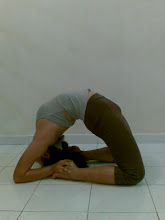This style of yoga is characterized by a focus on viṅyāsa, or a dynamic connecting posture, that creates a flow between the more static traditional yoga postures. Vinyasa translates as linking and the system also implies the linking of the movement to the breath. Essentially the breath dictates the movement and the length of time held in the postures. Unlike some Hatha yoga styles, attention is also placed on the journey between the postures not just the postures themselves. The viṅyāsa 'flow' is a variant of Sūrya namaskāra, the Sun Salutation. The whole practice is defined by six specific series of postures, always done in the same order, combined with specific breathing patterns (ujjāyī breathing).
A standard viṅyāsa consists (for example) of the flow from caturaṅga, or plank, to caturaṅga daṇḍāsana, or low plank, to ūrdhva mukha śvānāsana or upward-facing dog, to Adho Mukha Svanasana, or downward-facing dog. The purpose of viṅyāsa is to create heat in the body, which leads to purification of the body through increased circulation and sweating. It also improves flexibility, as well as tendon and hard tissue strength, allowing the student to practice advanced āsanas with reduced risk of injury.
There are six series altogether. Each sequence typically begins with 10 Sun Salutations and the standing poses. This is referred to as the "opening sequence". The student then moves to either the Primary, Intermediate, Advanced A, B, C, or D, depending on his or her skill level, a back-bending sequence, finally closing with a set of inverted postures, referred to as the "finishing sequence". Ashtanga Yoga is traditionally taught in Mysore style (supervised self practice), where each student moves through the practice at his or her own pace and level. In the West, it is more common to find classes devoted to a specific series, and guided by an instructor.
chloe CHAT yoga BOX
CHLOE CONTACT
H/P: 012 6868 226
Email: chloeleow_88@hotmail.com
pls do not hesitate to ask, i LOVE to get ur comment
together LOVE yoga, LEARN yoga, PLAY yoga & LIVE yoga
Email: chloeleow_88@hotmail.com
pls do not hesitate to ask, i LOVE to get ur comment
together LOVE yoga, LEARN yoga, PLAY yoga & LIVE yoga
MY YOGA CLASSES SCHEDULE
Mon 8.30pm-9.30pm bayu perdana
Thurs 6.30pm-7.30pm klang parade
Sun 9.30am-10.30am klang parade


0 comments:
Post a Comment